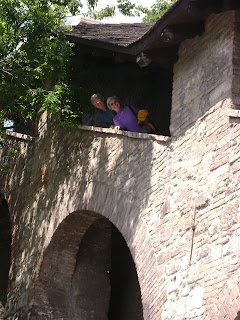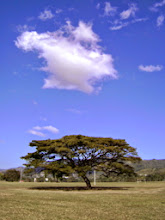 Budapest is quite spectacular. The castle sits on a big rock outcrop overlooking the Danube which curves elegantly through the center, dividing Buda from Pest. It's full of grand, imposing buildings from around the mid 1800s and more statues than I have ever seen anywhere. It's made to impress.
Budapest is quite spectacular. The castle sits on a big rock outcrop overlooking the Danube which curves elegantly through the center, dividing Buda from Pest. It's full of grand, imposing buildings from around the mid 1800s and more statues than I have ever seen anywhere. It's made to impress.I didn't know much about Hungary beforehand, other than it was part of the Austro-Hungarian empire, and that they're big fans of paprika.

But it was (sort of) on my way home and neither my parents nor I had ever been, so we decided to meet up and see something new together. I was late because my train from Warsaw was stuck locomotiveless for about 5 hours in Breclav (Czech Republic?), so Claire and Paul were waiting for me at the station when I got there.

On Saturday we visited the Grand Market, designed by Gustav Eiffel, and toured the World War II hospital that was built in the caves under the castle (C+P pictured heading down to the hospital entrance, left).
Sunday was Pentecost, and there was mass in St Matyas church (roof at right) with a full orchestra and choir singing Mozart. The mass was half in Latin and half in Hungarian. I didn't understand anything, but, man, it was impressive!

In the afternoon we went to the Jewish quarter. We visited the orthodox synagogue, which is little more than a shell now, and the Jewish Museum and Grand Synagogue. They're the original buildings, because the Nazis didn't have time to destroy them, having occupied Hungary from March 1944 - setting up the ghetto only that November - to January 1945. They managed to exterminate 130,000 people, but it's nice somehow that some of the beautiful things those people made have survived.
It was a beautiful weekend, with great weather and lots of fascinating things to see. The food was terrific too, and we found lots of opportunities to fit it in. And pastries. Mmm.
Vienna, on the other hand, was a bust. I couldn't get in touch with the hostel where I was planning to stay and didn't know of anywhere else and the guys at the information counter and at the tabac - where they sell phonecards - were not nice and the payphones didn't work. I was tired and cranky and couldn't come up with a good answer to 'why not just go home?'

So I bought my ticket back to Geneva for that evening. Having committed to leaving Vienna, it didn't seem that bad at all. There was a festival going on outside the Rathaus (a suitable name for all government buildings?) and lots of people out in all the parks. It was a very pretty evening, and I had 4 pleasant hours wandering around. Maybe I'll go back.























